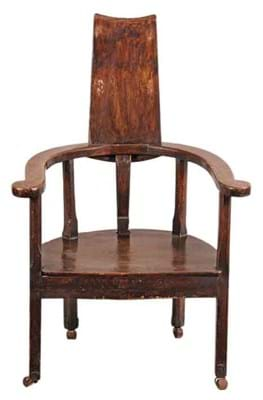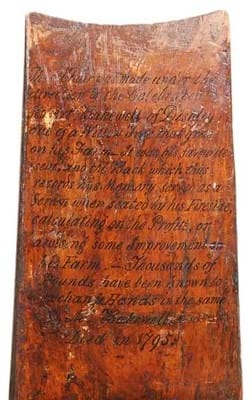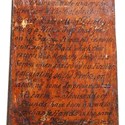Separating males from females to 'breed in' desirable characteristics, his advancements not only led to specific improvements in sheep, cattle and horses, but contributed to the general knowledge of artificial selection that remains the blueprint for all modern farm breeds.
We also know what his favourite chair looked like.
The inscription in copperplate writing to the back rest of this George III armchair reads thus: This chair was made under the direction of the Celebrated Robert Bakewell of Dishley out of a Willow Tree that grew on his farm. It was his favourite seat and the Back which thus records his Memory, served as a Screen when seated by his Fireside, calculating on the Profits, or devising some Improvements on his Farm. Thousands of Pounds have been known to exchange Hands in the same… Mr. Bakewell Died in 1795.
It is unusual to know with any degree of certainty the original owner of any vernacular chair and to know the circumstances of its making. The information accompanying this example, made c.1750 in willow with oak and elm as secondary woods, however has doubtless survived due to the fame of its owner.
Measuring a generous 2ft 7½in (80cm) wide and showing signs of repair and renewal consummate with its two and a half centuries, the Robert Bakewell chair was the one piece of furniture among the group of items that formed the collection of the Royal Agricultural Society of England.
Pension Fund Deficit
Removed from the RASE base in Stoneleigh Park, the collection was sold by Dreweatts & Bloomsbury in London on July 11 to clear a pension fund deficit and raise funds for an Innovation in Agriculture scheme. More than 40 cattle society trophies were withdrawn prior to sale after objections from breed societies and the descendants of original donors.
Alongside the Society's portrait of HRH Princess Elizabeth painted in 1950 by Sir Oswald Birley, sold for £40,000, the chair ranked high among the lights of the sale, selling at £9000 (plus 24% buyer's premium). The successful buyer was the Arundel dealer Spencer Swaffer, who bought it for stock but has already sold it to a client.
"It is a remarkable chair in both scale and provenance," he told ATG. "Ever the optimist, and with an estimate of £500 to £800, I was convinced it would slip through unnoticed. No such luck, but I still thought the price was reasonable."
After the sale he found himself being interviewed by a journalist from Farmers Weekly who had covered all the run-up to a controversial sale with interest. "That was a first," he said.
An interview with Spencer Swaffer will appear in next week's issue of ATG's printed newspaper. More highlights from the £400,000 Royal Agricultural Society of England collection will be reported in the same issue.









